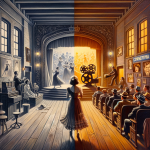Now Reading: A Deep Dive into the 1995 Film ‘Smoke’ by Wayne Wang and Paul Auster
-
01
A Deep Dive into the 1995 Film ‘Smoke’ by Wayne Wang and Paul Auster
A Deep Dive into the 1995 Film ‘Smoke’ by Wayne Wang and Paul Auster

A Deep Dive into the 1995 Film ‘Smoke’ by Wayne Wang and Paul Auster
The 1995 film “Smoke”, co-directed by Wayne Wang and Paul Auster, is a profound exploration of human connections and the intricate tapestry of life within a Brooklyn neighborhood. Set primarily in a quaint cigar shop located at the corner of 16th Street and Prospect Park West, the film intricately weaves together the lives of its diverse characters, each bringing their own stories and experiences to the narrative.
The Setting: A Cigar Shop at the Heart of Brooklyn
A pivotal aspect of “Smoke” is its setting in a local cigar shop. This shop symbolizes not only a place of commerce but also a community hub where people from different walks of life intersect. The shop, managed by the amiable Augie Wren (played by Harvey Keitel), serves as the backdrop for numerous poignant interactions that unfold throughout the film.
Characters and Their Stories
The characters in “Smoke” are as diverse as the neighborhood itself, each contributing unique narratives that reflect the complexities of life. Here are some key individuals and their story arcs:
- Augie Wren: The cigar shop owner, whose own life experiences deeply influence those around him.
- Paul Benjamin: A writer grappling with his past, played by William Hurt.
- Rashid: A young man who becomes entangled in the lives of the cigar shop regulars and holds a mysterious connection to Augie’s past.
Thematic Elements and Messages
“Smoke” is not just a film about a cigar shop; it delves into deeper themes such as identity, community, and the passage of time. The stories shared among the characters often touch upon the following prominent themes:
- Connection: The film illustrates the human need for connection in a bustling urban environment.
- Storytelling: Each character’s story evokes the art of storytelling, emphasizing its role in human experience.
- Mortality: The film contemplates mortality and how it shapes our relationships and choices.
The Impact of “Smoke” on Cinema
“Smoke” received critical acclaim upon its release and has been recognized as a significant work in the realm of independent cinema. Its unique narrative structure, which includes a mix of interconnected stories, has inspired countless filmmakers and altered how stories can be told on screen.
Moreover, the film showcases the talents of its directors in crafting a compelling narrative that weaves together character-driven stories, highlighting the beauty of everyday life and the complexity of human relationships. The performances by its cast further elevate the material, making “Smoke” a timeless piece of storytelling.
Conclusion: A Celebrated Piece of Storytelling
In conclusion, “Smoke” is more than just a film; it’s a celebration of the human experience captured beautifully within the confines of a Brooklyn cigar shop. Wayne Wang and Paul Auster’s collaborative vision brings to life the richness of neighborhood dynamics and the profound stories that unfold in seemingly mundane settings. As audiences continue to discover or revisit this remarkable film, they are invited to reflect on their connections, their narratives, and the beauty that resides within their own lives.
Stay Informed With the Latest & Most Important News
Previous Post
Next Post
-
 01Famous Writers from Brooklyn, New York
01Famous Writers from Brooklyn, New York -
 02A Comprehensive Look at Famous Novelists from Brooklyn, New York
02A Comprehensive Look at Famous Novelists from Brooklyn, New York -
 03The Impactful Journey of Donald Joel Aronow: A Boat Design Pioneer
03The Impactful Journey of Donald Joel Aronow: A Boat Design Pioneer -
 04A Scenic Journey: The Staten Island Ferry from Brooklyn to Manhattan
04A Scenic Journey: The Staten Island Ferry from Brooklyn to Manhattan -
 05Famous Sports Stars from Brooklyn, New York
05Famous Sports Stars from Brooklyn, New York -
 06A Look Back at the 1977 Brooklyn Blackout: Causes and Impacts
06A Look Back at the 1977 Brooklyn Blackout: Causes and Impacts -
 07A Comprehensive Look at Barry Manilow’s Brooklyn Roots
07A Comprehensive Look at Barry Manilow’s Brooklyn Roots

































